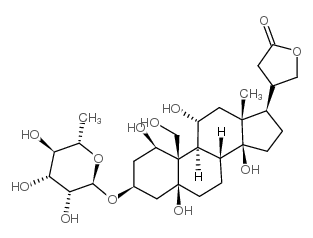Isoform-specific function and distribution of Na/K pumps in the frog lens epithelium.
J Gao, X Sun, V Yatsula, R S Wymore, R T Mathias
文献索引:J. Membr. Biol. 178(2) , 89-101, (2000)
全文:HTML全文
摘要
Epithelial cells from the anterior and equatorial surfaces of the frog lens were isolated and used the same day for studies of the Na/K ATPase. RNase protection assays showed that all cells express alpha(1)- and alpha(2)-isoforms of the Na/K pump but not the alpha(3)-isoform, however the alpha(2)-isoform dominates in anterior cells whereas the alpha(1)-isoform dominates in equatorial cells. The whole cell patch-clamp technique was used to record functional properties of the Na/K pump current (I(P)), defined as the current specifically inhibited by dihydro-ouabain (DHO). DHO-I(P) blockade data indicate the alpha(1)-isoform has a dissociation constant of 100 microm DHO whereas for the alpha(2)-isoform it is 0.75 microm DHO. Both alpha(1)- and alpha(2)-isoforms are half maximally activated at an intracellular Na(+)-concentration of 9 mm. The alpha(1)-isoform is half maximally activated at an extracellular K(+)-concentration of 3.9 mm whereas for the alpha(2)-isoform, half maximal activation occurs at 0.4 mm. Lastly, transport by the alpha(1)-isoform is inhibited by a drop in extracellular pH, which does not affect transport by the alpha(2)-isoform. Under normal physiological conditions, I(P) in equatorial cells is approximately 0.23 microA/microF, and in anterior cells it is about 0.14 microA/microF. These current densities refer to the area of cell membrane assuming a capacitance of around 1 microF/cm(2). Because cell size and geometry are different at the equatorial vs. anterior surface of the intact lens, we estimate Na/K pump current density per area of lens surface to be around 10 microA/cm(2) at the equator vs. 0.5 microA/cm(2) at the anterior pole.
相关化合物
| 结构式 | 名称/CAS号 | 分子式 | 全部文献 |
|---|---|---|---|
 |
二氢乌本箭毒苷
CAS:1183-35-3 |
C29H46O12 |
|
Sodium-potassium-ATPase electrogenicity in cerebral precapil...
2000-07-01 [Am. J. Physiol. Heart Circ. Physiol. 279(1) , H351-60, (2000)] |
|
Na(+)/K(+)-ATPase inhibition upregulates NMDA-evoked current...
2012-08-01 [Fundam. Clin. Pharmacol. 26(4) , 503-12, (2012)] |
|
Contribution of cytosolic ionic and energetic milieu change ...
1998-01-01 [J. Cardiovasc. Pharmacol. 31(1) , 146-56, (1998)] |
|
Novel form of LTD induced by transient, partial inhibition o...
2004-01-01 [J. Neurophysiol. 91(1) , 239-47, (2004)] |
|
Mammalian cardenolides in cancer prevention and therapeutics...
2008-04-01 [Ther. Drug Monit. 30(2) , 234-8, (2008)] |